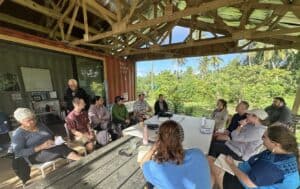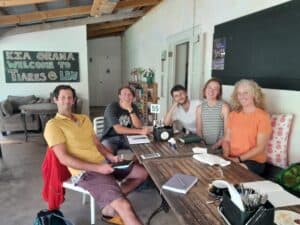Effective stream monitoring involves a systematic observation and analysis to assess general stream health and ecological integrity.
Te Ipukarea Society has been working with Muri Environmental Care to upskill ourselves in how to conduct useful stream surveys.
The equipment we are using to conduct surveys of the stream comes from the Stream Health Monitoring Assessment Kit (SHMACK), a water surveying kit organised by The National Institute of Water and Atmospheric Research (NIWA).
These kits provide a way to assess whether land-use practices are affecting water quality by tracking the health of the stream over time.
Entomologist Mike Bowie from the Ministry of Agriculture has also assisted the team in identifying insects found within the streams.
A survey led by our newest staff member, Akeina Tairea, in the Takuvaine stream concluded that the quality of the stream water diminishes as it passes through the places where people live.
Four areas of the stream were tested for levels of nitrogen, phosphates and dissolved oxygen.
Nitrogen and phosphorus are essential nutrients for plant growth. However, excessive levels pollute the water, resulting in algal outbreaks and decreased oxygen which stream life needs to survive.
Talk about chemistry 101!
Streams are considered a sensitive indicator of environmental change, where monitoring efforts allow us to track changes in biodiversity, shifts in land use or pollution levels, and therefore advise us on what targeted conservation efforts are needed.
Regular monitoring basically allows for early proactive measures to mitigate negative consequences later down the track.
During our last two school holiday programmes, we have included a session on stream monitoring.
Now that we are building our own skill set using the SHMAC test kits, we aim to involve more students in stream monitoring practices.
This fosters a sense of environmental stewardship in our youth, and may also help encourage eco-conscious habits in their own households.
For example, tying pigs too close to streams can add a lot of nitrates to the stream, and ultimately out into the lagoon, where it can cause outbreaks of seaweed such as what we have seen in recent years.
We will be collaborating with the Muri Environment Care to get a better understanding of how streams respond to environmental changes and stressors which is crucial for building resilience.
This knowledge helps communities and ecosystems within the stream adapt to changes, ensuring sustainable coexistence with nature.
This work will also build on the ongoing efforts of the Ministry of Marine Resources, who run regular stream monitoring of Rarotonga’s streams closer to the coastline.
Our venture into stream monitoring aligns with our broader goal of preserving those stream ecosystems that are connected from our mountain ridge to our reef.
We face intense environmental challenges such as rising sea levels and coral bleaching. Stream monitoring provides us design to assist with localised and actionable strategy to help address these issues at the grassroots level.
We look forward to continuing collaboration with others involved in looking after our natural heritage.



